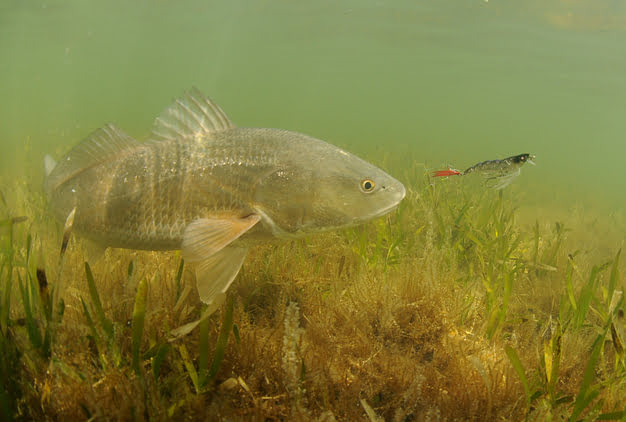The diverse drum family (sciaenidae) is one of the most commonly encountered fish families by anglers in the U.S. Southeast.
The biggest, meanest, and most prized drum species from the American East are the Red Drum or Redfish (Sciaenops occelatus) and the Black Drum (Pogonias cromis).
Both can grow to over 5 feet long and weigh around 100 pounds, and neither are particularly picky about their diet, making them ideal inshore gamefish.
Hook up with either species and you’re in for a hard-fought battle, no doubt. But with so many different names and species to keep track of, it’s no wonder anglers get the two mixed up!
Do These Colors Make my Fins Look Fat?
Red and black drum both live primarily around sand and mud flats along coastal beaches and estuaries. If anglers can find one of them, they can often expect to find both.
As their names suggest, the fish’s colors can be a good tell. Both fish are silvery, but red drum have a noticeable red hue to their scales while adult black drum are usually a dull gray.
Patterning can help, too; red drum have small black ‘eyespots’ near their tails that help deter predators, and young black drum have black vertical bars running down their sides that break up their silhouette.

Red drum will keep their spot as they age, while black drum slowly lose their stripes over time.
Black drum are generally rounder and stockier than red drum, which take on a slender, more streamlined shape.
Black drum also possess sensory barbels on the underside of their mouth, which they use to sift through the sediment for tasty morsels. Red drum lack these barbels entirely; if it has a “beard,” it’s a black drum!

When compared side by side, the two species are fairly easy to tell apart. But, I have seen red drum (redfish) without any spots, and with a silver color and almost no red. This can make you question whether or not its a black drum.
Take note of the overall body profile size; is the fish short and stocky, with a tall vertical appearance and big ‘shoulders’? If so its likely a black drum.
If the fish is long and slender, with a more rounded overall shape, spots on its tail and any hints of red, cinnamon, or ginger coloration? If so, it’s likely a red drum.
For me personally, I love redfish but think black drum get a bad wrap. They may be big, and ugly…but they are a unique native fish that deserves some recognition!
How do I Get Red and Black Drum On the Hook?
Red and black drum also share many common dietary habits, meaning that the same general setups will work for both species. If you’re only after one species and want to avoid the other, then the calendar is your friend!
Black drum spawn between April and June, while red drum wait until August and spawn clean through to November in some areas.
Spawning season is generally when these fish are at their most aggressive, so timing can be everything when finding your desired bite. Local guides and fishing reports can provide invaluable information on when certain species are spawning near you.
Natural baits are your best bet, and both species of drum will feast on live shrimp or peeler crabs like they’re candy. Cutbait is a perfectly serviceable option as well; shrimp, squid, mullet or pinfish can all draw a bite.

However, if I wanted to exclusively target red drum I would use cut mullet, pinfish, or live shrimp. And if I wanted to specifically target black drum, I would opt for blue crab, shrimp or clams.
When using natural baits to fish for drum, bottom rigs (such as fishfinder or hi-lo rigs) with a heavy sinker are the easiest and lowest effort option.
Just cast, sit back, and wait for a bite! Using a popping cork to mimic feeding fish requires a little bit more activity, but can prove very effective.
Artificial lures can work too if you don’t want to get your hands dirty. Slowly bouncing a heavy jig along the bottom can tempt a hungry drum to strike.
However you choose to fish, once you have a drum on the line, prepare for the fight of your life!
A Test of Strength: How Does Each Fish Fight?
These two titans of the inshore realm can both be highly challenging (and rewarding) to land. Brace yourself for long, repetitive runs- I have seen these fish take upwards of half an hour to land from the beach!
Your arms are in for a workout, but you’ll have a fisherman’s tale worth telling.
Red drum are thought to be the ‘better’ fighter based on muscle alone, since they’re leaner and faster than their black drum cousins. Yet what black drum lack in athleticism they more than make up for in raw mass and stubbornness.
In my personal experience, black drum fight a lot like common carp do in freshwater. While they may not jump or make daring runs, their raw strength makes them monsters all the same.
A hookup with a fully grown black drum may even feel like a snag at first due to their sheer bulk!
When you set the hook on a big black drum, there is often a 1-2 second delay, before the fish realizes he’s been hooked. Then, a long and steady deep driving run of steady peeling drag.
Large red drum are similar, and often caught in the surf along beaches or in current, making for an even more challenging fight.

Neither fish are known for their jumps, but redfish will sometimes come to the surface and headshake. Most of the time though, these brutes are face down, tail up and digging to the bottom and deeper water.
Medium to Medium-Heavy tackle is ideal.
Which Fish Makes A Better Meal?
I’ve ranked a list of some of the best tasting fish, and according to my research and testing, the red drum slightly outranks the black drum with an overall ranking of B+. The black drum earned a score of B-.
Regardless, most anglers will tell you that only small drum of either type are worth eating; a common guideline is under 10 pounds for red drum and under 8 pounds for black drum.
Both species are said to have a mild, firm, and tasty flesh. They can be prepared a number of ways, including broiling, grilling, or baking, but my personal favorite way to enjoy my catch is batter-fried, served on a hot brioche bun with some tartar sauce.
The only thing that’s (almost) as good as a day on the water is the homemade meal afterwards!
Frequently Asked Questions
Which Fish Gets Bigger? Black Drum Or Red Drum?
Black Drum grow larger in overall weight, with the largest on record weighing a staggering 113 lbs 1 ounce.
Red Drum are common up to 50 pounds, and have been caught up to 90 lbs, but typically grow longer in overall length.
Which Fish Is Easier To Catch, Black Drum Or Red Drum?
Neither black drum or red drum have a reputation as a picky, or difficult fish to catch. Locating active fish and presenting a bait is usually the difficult part.
Do Black Drum and Red Drum Have Worms?
Both fish are susceptible to internal parasites, but the black drum especially large fish over 25 lbs have an increased chance to find worms.
Conclusion
Now that you’re a certified expert on the differences between black drum vs red drum, it’s time to go out there and catch some!
Whichever species you end up facing off against, you can be sure to expect a thrilling day on the water thanks to these two titan species of drums.

Growing up in Florida, I’ve been surrounded by saltwater my entire life…and I love sharing my passion with others.
To learn more about why I started Saltwater Mecca, visit the ABOUT page.
Thank you for reading this article. Browse around & have some fun!